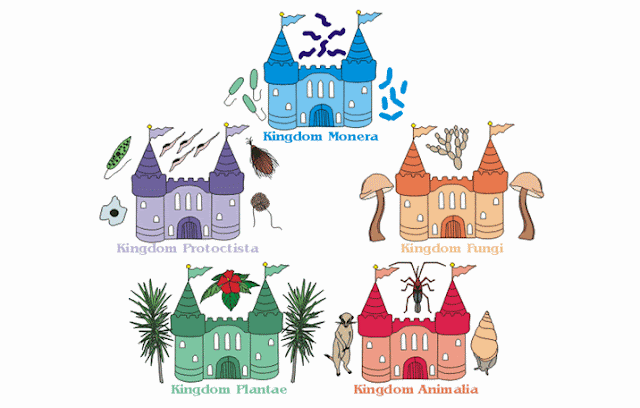Classification of living things is based on the
experts opinion to be used as an international standard. Therefore, the
classification of living beings is very diverse, because there is a lot of
difference in their opinions. In this article we will try to explain 5 Kingdom
Classification of Living Things (Organisms)
A. THE BASIC OF CLASSIFICATION SYSTEMS OF
LIVING THINGS (ORGANISMS)
The classification of living things have apply
internationally, so the classification that has prevailed is not a mere hoax, because
it has been agreed internationally. The purpose of this classification is to
simplify the study of living beings. Living beings are grouped by similarity of
its characteristics, each level of grouping is called a taxonomy levels. The
higher their position in taxonomy level, the less their similarity.
Characteristics which form the basis of this classification is morphology (form
the outside), anatomy (body composition), physiology, biochemical properties,
and genetic.
B. 5 KINGDOM CLASSIFICATION SYSTEM
As I have explained in the introduction, the system
of classification of living things can be different according to the experts
who put it forward. In this article we will discuss about the classification
system proposed by Robert H. Whittaker : 5 kingdom classification system.
According to him, living things are divided into Monera, Protista, Function
(mushrooms), Plantae (plants) and Animalia (animals) Kingdom. In addition to
the five kingdoms, there is also a class of viruses, virus not included in the
kingdom of living beings, because the virus has characteristics that is
different with other living beings.
Each Kingdom is divided into several phyla (for
animals) and division (for plants), then every phylum or division is divided
into several orders, each order is subdivided into several families, each
family is subdivided into several genus, and each genus is subdivided into
several species (kinds).
Here are a few words about the characteristics of the
5 kingdom classification above:
1. Monera
Monera is a kingdom of living beings that do not have
a nuclear membrane (prokaryotic organisms). However, although it has no nuclear
membrane, this organism has the core material, the core material in the form of
acid or DNA. Examples of prokaryotic organisms are bacteria. All moner
activities, such as exchange of substances and breeding, carried by the cell
itself.
2. Protists
Protist kingdom of living beings are composed of a
single cell or multiple cells that has the nuclear membrane (eukaryotic
organisms). All activities performed by the living protist cell itself. This Life
activities include dining, gas exchange, respond to stimuli, and movement. There
are 3 group of Protists; Animal-like Protists (protozoa) dan Plantlike Protists
(algae), and Fungi-like Protists. Algae have chlorophyll to do photosynthesis
process that can produce food, on the contrary, protozoa do not have
chlorophyll so that it can not produce food by itself. Fungi Like Protists has
a similar reproduction process like fungi.
3. Fungi
(Mushrooms)
Fungi is a kingdom of living beings who do not have
chloroplasts. Mushroom body consisting of a cells in the form of threads, cell
wall composed of chitin substance (as in human fingernails). This Chitin made
fungus can not be grouped into a plant or animal.
4. Plantae
(Plants)
Plantae or plant kingdom are multicellular living
beings that have chloroplasts. Chlorophyll contained within this chloroplasts. Because
they have chlorophyll, the plants can perform photosynthesis. Plant cells are
eukaryotic (have a nuclear membrane) and cell wall composed of cellulose.
Plants generally have roots, stems, and leaves, except the moss with roots
apparent (Rhizoid). Plant breeding and mating with the “unmarried way”.
Breeding in the mating carried out by a specialized organ that produces gametes
cells. Seed is the product of their fertilization (conception)
5. Animalia
(Animals)
Animalia is the animal kingdom. Their cells have nucleus
membrane (eukaryotes) and do not have chloroplasts. Contrast to the plants,
animals can move freely and have a nervous system.
Viruses are not included into the 5 kingdom. Their
Characteristics are :
- Virus only have one type of core protein (DNA or RNA only).
- Virus body is smaller than a cell.
- Virus reproduction occurs by copying their acid core.



